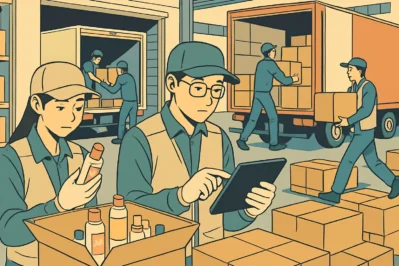Unlock Korean Trade: Your Guide to Warehouse Vocabulary!
Hello! This is Everyday Korean, here to upgrade your Korean skills!
Today, we’re stepping into the fast-paced world of international trade and logistics. We’ll learn the essential Korean vocabulary for describing what happens in a warehouse when imported goods arrive. This is incredibly useful if you work in e-commerce, supply chain management, or any business that handles physical products.
These days in Korea, with the global boom in K-pop merchandise and K-beauty products, logistics and efficient warehouse management are more important than ever. Mastering these terms will not only boost your vocabulary but also help you understand the engine behind the Hallyu wave!
Core Expressions You Need to Know
Here are the key terms that will make you sound like a logistics pro.
1. 입고되다 (ip-go-doe-da)
- Pronunciation: [ip-go-dwe-da]
- English Meaning: To be received; to be stocked.
- Detailed Explanation: This is a crucial passive verb. It’s formed from 입 (入), meaning ‘enter’, and 고 (庫), meaning ‘warehouse’. So, it literally means “to be entered into the warehouse.” It’s the formal, professional term used when a shipment officially arrives and is logged into the system.
2. 검수하다 (geom-su-ha-da)
- Pronunciation: [geom-su-ha-da]
- English Meaning: To inspect; to check.
- Detailed Explanation: This term combines 검 (檢), ‘to inspect’, and 수 (收), ‘to receive’. 검수하다 is the action of carefully checking the newly arrived goods. Does the quantity match the packing list? Is anything damaged? This is a vital quality control step in any warehouse.
3. 재고를 파악하다 (jae-go-reul pa-ak-ha-da)
- Pronunciation: [jae-go-reul pa-ak-ha-da]
- English Meaning: To check the inventory; to get a grasp of the stock.
- Detailed Explanation: 재고 (jaego) means ‘inventory’ or ‘stock’. While you could use the simpler verb 확인하다 (to check), 파악하다 (pa-ak-ha-da) has a deeper nuance of ‘to grasp fully’ or ‘to understand the situation’. This phrase is used when you need a comprehensive understanding of current stock levels. It sounds very professional.
4. 출고되다 (chul-go-doe-da)
- Pronunciation: [chul-go-dwe-da]
- English Meaning: To be shipped out; to be dispatched.
- Detailed Explanation: This is the direct opposite of 입고되다. It uses 출 (出), meaning ‘exit’, and 고 (庫), meaning ‘warehouse’. This passive verb is used when products are officially processed to leave the warehouse to be sent to customers or retail stores.
Example Dialogue
Let’s see how these words are used in a real conversation between two logistics team members, Min-jun and Brian.
A (민준): 브라이언 씨, 오전에 주문한 화장품이 방금 입고되었어요.
Brian, the cosmetics we ordered this morning have just been received.
B (브라이언): 아, 네. 그럼 제가 바로 가서 검수할게요. 지난번 물건 재고를 파악했어요?
Oh, okay. I’ll go and inspect them right away. Did you check the inventory for the last shipment?
A (민준): 네, 시스템에 업데이트했습니다. 그 물건은 내일 오전에 출고될 거예요.
Yes, I’ve updated the system. That shipment will be dispatched tomorrow morning.
B (브라이언): 좋습니다. 모든 게 순조롭게 진행되고 있네요.
Great. Everything is proceeding smoothly.
Culture Tip: The “Palli-Palli” of Korean Logistics
You might know the famous Korean phrase 빨리빨리 (palli-palli), which means “hurry, hurry!” This cultural mindset is the driving force behind Korea’s incredibly efficient logistics industry. When you hear terms like 입고되다 and 출고되다, they aren’t just words; they represent a system built for speed and precision.
For example, e-commerce giants in Korea offer “rocket delivery” (로켓배송), promising next-day or even same-day arrival. This is only possible because the process of 입고, 검수, and 출고 happens with lightning speed at massive logistics hubs. So, when you use these terms in a business setting, remember the underlying cultural value placed on speed and accuracy. Saying something like “신속하게 검수하겠습니다” (I will inspect it promptly) will surely impress your Korean colleagues!
Wrap-up & Practice Time!
Amazing work today! You’ve learned four key professional terms—입고되다, 검수하다, 재고를 파악하다, and 출고되다—that are essential for understanding Korean business and logistics.
Now, let’s test your knowledge! Fill in the blanks with the correct expression from today’s lesson.
- 컨테이너가 항구에 도착하면, 물건은 창고로 ________.
(When the container arrives at the port, the goods are ________ into the warehouse.) -
주문서와 물건의 수량이 맞는지 ________ 합니다.
(We must ________ if the quantity of goods matches the order form.)
Challenge: Leave a comment below creating your own sentence using one of the expressions we learned today! We can’t wait to see what you come up with.






